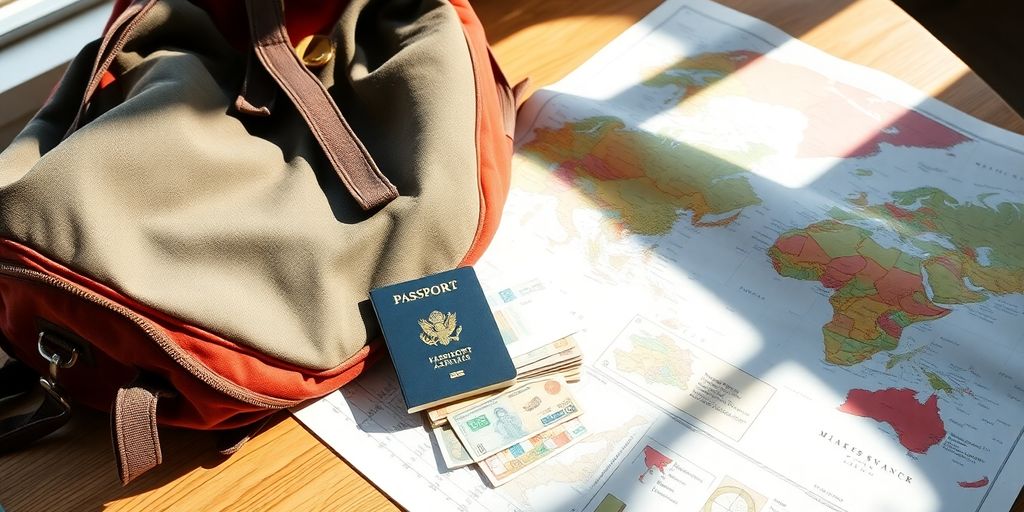Study Abroad Scholarships: Get Paid to Travel in 2026
Dreaming of studying abroad but worried about the cost? Good news! Lots of money for scholarships goes unused every year because people just don’t apply for it. This article is all about how you can grab some of that cash for your own adventure. We’ll cover everything from finding government aid to getting money from your school and even special groups. So, if you want to travel and learn in 2026, keep reading to find out how to make it happen without breaking the bank. It’s totally possible to get Study Abroad Scholarships: Get Paid to Travel in 2026!
Key Takeaways
- Lots of scholarship money goes unclaimed each year, so there’s a good chance for you to get some.
- You can find scholarships through your home university, program providers, and even cultural groups.
- Federal financial aid might be able to help with your international study costs.
- There are specific scholarships for different regions, like Europe and Asia, and for diverse students.
- Don’t forget to look for less obvious funding sources and apply early for the best shot.
Unlocking Funding Opportunities for Your Study Abroad Journey

So, you’re dreaming of studying abroad in 2026? Awesome! But let’s be real, the first thing most people think about is money. Don’t let that stop you! There are tons of ways to make it happen. Let’s explore some key avenues for finding those sweet, sweet scholarships and grants.
Federal Financial Aid for International Study
Did you know that your existing federal financial aid might actually travel with you? It’s true! Many students don’t realize that federal grants and loans can be used for study abroad programs. The first step? Fill out the FAFSA (Free Application for Federal Student Aid). It’s not just for tuition at home; it can open doors to potential funding sources overseas too. It’s definitely worth checking out!
Leveraging University Resources for Scholarships
Your university is a goldmine of information and, more importantly, funding. Seriously, don’t skip this step. Here’s what you should do:
- Talk to your financial aid office. They know the ins and outs of available aid.
- Visit the study abroad office. These folks are experts in finding programs and funding.
- Check with specific departments (like foreign language or your major). They often have scholarships you didn’t even know existed.
Don’t be shy about asking questions. The people in these offices are there to help you achieve your study abroad dreams. They can point you toward scholarships tailored to your program, destination, or field of study.
Community and Cultural Organization Grants
Think local! Many community and cultural organizations offer grants to students studying abroad, especially if your program relates to their mission or the country they represent. Consider these:
- Local chapters of cultural organizations (German clubs, Italian-American societies, etc.).
- Community foundations that support education and international exchange.
- Religious organizations that offer scholarships for study in specific regions.
Navigating Scholarship Applications for 2026
Okay, so you’re thinking about studying abroad in 2026? Awesome! But let’s be real, it costs money. Scholarships are your best friend here, but getting them isn’t always a walk in the park. It’s all about playing the game smart. Let’s break down how to actually win at this scholarship thing.
Understanding Need-Based Scholarship Criteria
Need-based scholarships are all about showing that you actually need the money. It’s not just about wanting to travel (though, who doesn’t?). These scholarships look at your family’s financial situation to figure out how much help you need. The big thing here is the FAFSA. Remember that the Expected Family Contribution (EFC) is now the Student Aid Index (SAI), so make sure you’re using the right numbers when you fill out your FAFSA. CIEE requires your current SAI details from your FAFSA Submission Summary for programs in 2025 and on. Basically, the lower your SAI, the better your chances for these scholarships. Also, some scholarships might ask for additional info, like tax returns or bank statements, so be ready to provide that stuff.
Key Deadlines for Study Abroad Scholarships
Deadlines are everything. Miss them, and you’re out of the running, no matter how amazing your application is. Start looking for scholarships early, like, really early. Some deadlines are almost a year before your program starts! Keep a spreadsheet or use a calendar to track every deadline. Set reminders for yourself, too. Don’t just assume you’ll remember. Applying early is crucial for competitive study abroad scholarships. Here’s a general idea of when to expect deadlines:
- Fall programs: February to April
- Spring programs: August to October
- Summer programs: November to January
It’s better to submit an application a week early than a day late. Seriously. Give yourself time to deal with any tech issues or last-minute questions.
Maximizing Your Scholarship Application
Okay, so you’ve found some scholarships and you know the deadlines. Now it’s time to make your application shine. Here’s the deal:
- Follow the instructions. This sounds obvious, but you’d be surprised how many people mess this up. Read everything carefully and answer every question completely. If they ask for a 500-word essay, don’t write 499 words. Or 501. Stick to the limit.
- Write a killer essay. This is your chance to show who you are and why you deserve the scholarship. Don’t just repeat your resume. Tell a story. Be authentic. Let your personality come through. Have someone proofread it for you. Fresh eyes can catch mistakes you missed.
- Get strong letters of recommendation. Ask professors or mentors who know you well and can speak to your abilities and character. Give them plenty of time to write the letter and provide them with all the information they need, like your resume, a statement of purpose, and the scholarship requirements.
Scholarships for Studying Abroad in Europe
Europe is a super popular place to study abroad, and luckily, there are scholarships to help make it happen. Whether you want to check out art history in Italy or study public health in Norway, there’s a ton of variety. Let’s look at some options.
German Academic Exchange Service Scholarships
DAAD, or the German Academic Exchange Service, gives out a bunch of scholarships every year. These are meant to help students study abroad for a semester or even get a postgraduate degree in Germany. It’s a great way to experience German culture and academics without breaking the bank. They have a bunch of different programs, so it’s worth checking out their website to see what fits your needs. You can find potential funding sources on their website.
The Kosciuszko Foundation Scholarships for Polish Heritage
If you’ve got Polish roots or are interested in studying in Poland, the Kosciuszko Foundation is the place to go. They offer scholarships to students of Polish descent, and also to those who want to study in Poland. It’s a fantastic way to connect with your heritage or explore a country with a rich history and culture.
Exploring European Regional Funding
Don’t forget to look into funding from specific European regions or even cities. Sometimes, local governments or organizations offer scholarships to attract international students. These might be smaller than national scholarships, but they can add up and make a big difference. Plus, they often come with unique opportunities to get involved in the local community.
It’s always a good idea to check with the embassy or consulate of the country you’re interested in. They often have information on scholarships and funding opportunities specifically for students from your country.
Scholarships for Studying Abroad in Asia
Asia is a HUGE continent, and studying there can be an amazing experience. From bustling cities to ancient temples, there’s so much to explore. But, let’s be real, it can also be expensive. Luckily, there are scholarships out there to help make your Asian adventure a reality. Let’s look at some options.
Freeman Asia Scholarships for Regional Exploration
If you’re thinking about dipping your toes into Asian studies, the Freeman Asia Scholarship is a solid choice. It gives between $3,000 and $7,000 for up to eight weeks of study in one of 15 Asian countries. It’s especially good if you haven’t spent much time in Asia before and want a shorter, focused experience. It can be used for travel and living expenses. To find more options, search for scholarships that fit your needs.
King Abdullah University International Scholarships
Okay, so this one is a bit specific, but if you’re into science and technology, listen up. King Abdullah University of Science and Technology (KAUST) in Saudi Arabia offers fully funded graduate studies. This KAUST Fellowship covers tuition, gives a monthly living allowance, and more. It’s a pretty sweet deal if KAUST has the program you want.
Taiwan Fellowships and Scholarships
Want to study in Taiwan? The Taiwanese government has your back with Taiwan Fellowships & Scholarships (TAFS). These scholarships are for Bachelor’s, Master’s, and PhD degrees. They cover tuition and give a monthly stipend for living costs. The catch? You apply through your local Taiwan embassy, so make sure you get on it early to meet those deadlines and requirements.
Securing a scholarship can significantly ease the financial burden of studying abroad. It’s not just about the money; it’s about opening doors to experiences and opportunities you might not otherwise have. Take the time to research, apply, and make your dream of studying in Asia a reality.
Here are some general tips for applying:
- Start early. Scholarship deadlines can sneak up on you.
- Tailor your application. Don’t just send the same essay to every scholarship.
- Proofread everything. Typos are a big no-no.
Specialized Scholarships for Diverse Students

It’s a great thing that many organizations recognize the importance of diversity and inclusion in study abroad programs. Because of this, there are scholarships specifically for students from underrepresented groups. These scholarships aim to make international experiences more accessible. Let’s explore some of these opportunities.
Scholarship Opportunities for BIPOC Students
Several scholarships are designed to support Black, Indigenous, and People of Color (BIPOC) students in their study abroad endeavors. These scholarships often consider both financial need and academic merit. For example, some programs offer scholarships specifically for students with identities historically underserved in education abroad, including African American/Black, Hispanic/Latino, Asian American, Alaskan Native, American Indian, and Native Hawaiian students. These scholarships can significantly reduce the financial burden of studying abroad, making it a reality for more students. You can also explore college groups for potential scholarship funding.
Scholarships for Specific Majors and Fields of Study
Beyond general diversity scholarships, many opportunities target students in specific academic fields. For instance, there’s a Women in STEM Scholarship annually assigned to female international/DACA students in a Science, Technology, Engineering, and Mathematics program. If you’re pursuing a degree in a high-demand field, be sure to research scholarships tailored to your major. These scholarships often come with additional benefits, such as mentorship programs and networking opportunities.
Program Provider Specific Funding
Many study abroad program providers also offer their own scholarships and grants. These awards are often specific to their programs and can be a great way to reduce costs. For example, Semester at Sea offers the Inclusive Engagement Scholarship, which gives preference for underrepresented identities. Winners are awarded $5,000 and have their flights covered through the scholarship. Always check the program provider’s website for scholarship information and application deadlines.
Don’t be afraid to reach out to the study abroad office at your university for guidance. They can help you identify program-specific funding and navigate the application process.
Here’s a quick look at some potential funding sources:
- Diversity Abroad Scholarships
- Fund for Education Abroad (FEA) Scholarships
- Program provider scholarships (e.g., Semester at Sea)
Strategic Approaches to Finding Unclaimed Scholarships
Identifying Underutilized Scholarship Resources
It’s easy to get caught up in the big-name scholarships, but often, the real gold lies in the less-known corners. Think about local community organizations, professional associations related to your field of study, or even smaller, family-run foundations. These places often have fewer applicants, boosting your chances significantly. Don’t just stick to the first page of Google results; dig deeper!
Proactive Search Strategies for Funding
Don’t wait for scholarships to come to you; go out and find them! Here’s a few ideas:
- Network: Talk to professors, advisors, and alumni who have studied abroad. They might know of niche scholarships or funding sources you haven’t considered.
- Target Specific Programs: Some study abroad programs have their own scholarships or grants that are less competitive than general awards.
- Think Local: Check with local businesses, clubs, and organizations in your hometown. They might offer scholarships to students pursuing international experiences.
It’s a good idea to keep a detailed spreadsheet of all the scholarships you’ve applied for, including deadlines, requirements, and application status. This helps you stay organized and avoid missing any opportunities.
The Power of Online Scholarship Databases
Online scholarship databases can be a great starting point, but it’s important to use them strategically. Don’t just apply for everything you see. Instead, use the filters to narrow down your search based on your major, background, and destination. Also, be sure to check out scholarship opportunities that are specifically for BIPOC students. Here are some popular databases to explore:
- FastWeb
- IIE Passport
- Scholarship Portal
Beyond Scholarships: Additional Funding Avenues

Okay, so scholarships are awesome, but what if you still need more cash? Don’t sweat it! There are other ways to make your study abroad dreams a reality. It might take some extra effort, but it’s totally doable.
Government Support for International Students
Did you know that some governments actually offer financial aid to international students? It’s true! The requirements and amounts vary a ton, but it’s worth checking out. For example, the Fulbright Program is a great option for U.S. students looking to study abroad. Look into the specific programs offered by your destination country. You might be surprised at what you find. Some countries prioritize certain fields of study, so if your major aligns, you could be in luck!
Exploring Work Opportunities While Studying Abroad
Working while studying abroad? Yep, it’s possible! Depending on your visa and the local laws, you might be able to get a part-time job. This can help cover living expenses and give you some extra spending money. Plus, it’s a fantastic way to immerse yourself in the local culture and meet new people. Just make sure you don’t overload yourself – your studies should still be your priority!
Creative Ways to Fund Your Travel
Okay, let’s get creative! Think outside the box. Here are a few ideas:
- Crowdfunding: Set up a GoFundMe or similar campaign and share your story. You’d be surprised who might be willing to help.
- Freelancing: If you have skills like writing, design, or coding, offer your services online. You can work remotely and earn money while you study.
- Selling your stuff: Declutter your room and sell items you no longer need. Every little bit helps!
Don’t be afraid to get resourceful. Look for opportunities to save money, like cooking your own meals instead of eating out all the time, or taking advantage of student discounts. Every penny counts when you’re on a budget!
Wrapping Things Up: Your Study Abroad Journey Awaits!
So, we’ve talked a lot about scholarships today. It might seem like a lot to take in, but honestly, finding money for study abroad is totally doable. Think of all the cool places you could go, the new things you could learn, and the people you could meet. Don’t let the cost stop you from having an amazing experience. There are so many ways to get help paying for it, you just have to look. Start digging, apply for everything you can, and before you know it, you could be packing your bags for an adventure. Good luck out there!
Frequently Asked Questions
Can I use my regular financial aid for study abroad?
Yes, many government aid programs, like those from FAFSA, can be used to help pay for studying abroad. You should check with your school’s financial aid office to see how this works for your specific program.
When should I start looking for study abroad scholarships?
It’s a good idea to start looking for scholarships at least a year before you plan to go. Many scholarships have early deadlines, sometimes even 18 months in advance.
Where can I find scholarships for studying abroad?
You can find scholarships from your home university, the organization running your study abroad program, and even local groups in your community. Websites like Go Overseas also list many scholarship opportunities.
What do scholarships usually look for in applicants?
Many scholarships look at your grades, your chosen major, where you want to study, and sometimes your financial need. Some also consider your background or specific interests.
Are there scholarships for specific types of students or studies?
Yes, there are many scholarships especially for students from diverse backgrounds, for specific fields of study, or even for certain countries or regions. You just need to do some searching!
What if I don’t get a scholarship?
Even if you don’t get a scholarship, you can still look into government support for international students, find part-time work while you’re abroad (if allowed), or explore other creative ways to save money for your trip.